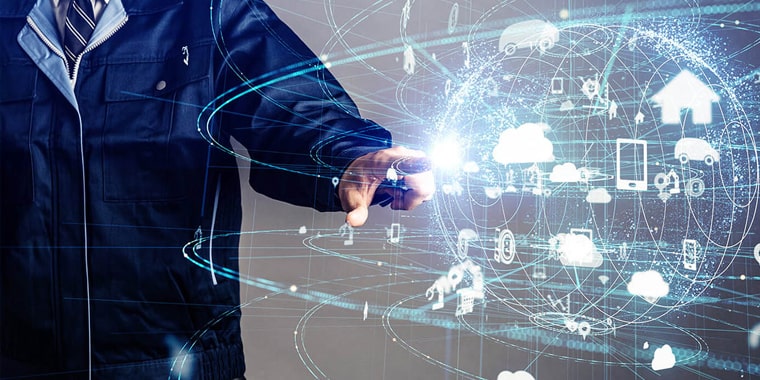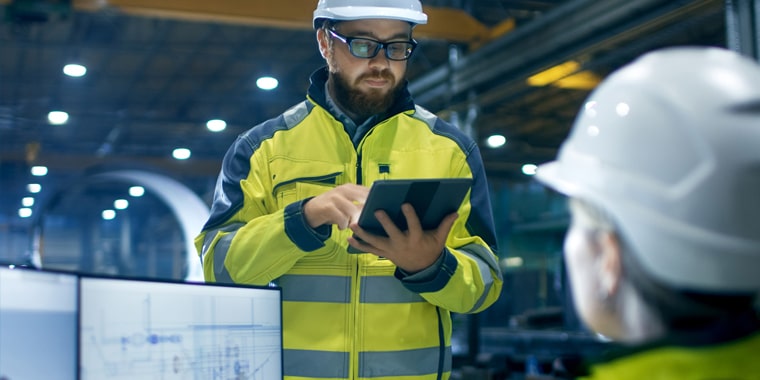
Benefits of ERP- IoT Integration
It’s a well-known fact that businesses can streamline, automate, and enhance their business operations by implementing an effective ERP solution.
The software provides real-time information from across the organization in a centralized dashboard, delivering valuable insights to decision-makers.
When we integrate ERP with IoT, the benefits are multifold.
This is because there is now a lot more data available via the connected sensors, and it affords an in-depth visibility into everything happening within the organization as well as the supply-chain.
The data generated by IoT is translated into valuable analytics that facilitate informed decision taking.
What is IoT and What is its Use?
The Internet of Things is a group of connected devices that have sensors to track, exchange, and generate reports on data.
The sensors capture data that cannot be normally recorded, like requirement for maintenance, production processes, tracking inventory (reading RFID tags through handheld devices), monitoring items as they move across the different phases of supply chain via GPS or similar technology, and more.
ALSO READ: Future of Enterprise Resource Planning
The Benefits of Integrating ERP and IoT

IoT ERP integration offers several benefits; data provided by IoT offers vital business information that helps to improve quality, productivity, and overall efficiency.
Let’s take a look at the chief benefits in detail:
1. Better Data Quality
When ERP software is integrated with IoT, businesses get more data, and in better quality too, which promotes growth.
The IoT sensors that are connected send encrypted data to the ERP system securely and without diluting the quality.
Any data that changes on the way to the ERP system gets automatically updated.
Let’s suppose a truck in your fleet breaks down; when the IoT sensors in the truck are linked to your ERP, the information will reach your system in real-time, enabling your team to take the necessary action to get the truck or its contents back on the road again to avoid shipping delays.
ALSO READ: PSA vs ERP
2. Improved Management of Supply Chain

You can get accurate info on the condition and status of inventory with smart IoT sensors.
Businesses can get to know how their assets are impacted by environmental and physical factors.
They can also verify if problems like poor packaging occurred, and also if weather conditions like humidity or extreme temperatures caused damage to the product.
Products are tracked throughout their journey, and organizations get real-time info about the location.
IoT can relay information about routes blocked because of weather or heavy traffic, allowing you to reroute your vehicles.
On receipt of products, the sensors can trigger activities like onward shipping and payments to vendors.
Warehouse staff can find products easily thanks to real-time location tracking.
Supply-chain cycles can be reduced as you get essential information faster as compared to manual methods.
When you have accurate inventory status, you can execute orders confidently.
Tracking inventory in its movement significantly lowers the chances of loss and theft; thus, IoT enables supply chain to be transparent, and more efficient.
ALSO READ: Emerging Trends in Supply Chain Management
3. Increased Insights and BI
When you have access to volumes of data and superior quality data, you can take informed business decisions as ERP turns the IoT-generated data into actionable information.
This in turn is conveyed to the relevant personnel who can take the right actions.
Thus, ERP and IoT combine to make businesses more proactive rather than reactive.
For any organization to grow and earn increased revenue, it is critical that they plan well and take the right decisions.
This integration is capable of delivering complex and in-depth business intelligence in real-time, facilitating decision-making.
It also eliminates paperwork and manual effort, simplifying the process with new technology.
4. Better Shop Floor Performance
IoT goes further than simple automation of manual processes.
Tasks that were considered ultra-intricate or extremely interconnected to be automated, can today be automated thanks to IoT.
This boosts productivity and enables ERP to offer real-time visibility into production, simplifying operations to offer step-by-step measures.
Enhanced automated brought in by IoT facilitates reduction of wastage, more streamlining, and even better profitability.
ALSO READ: Benefits of Implementing ERP for Oil and Gas Industry
5. Greater Operational Efficiency
IoT in ERP increases automation even further, helping to boost operational efficiency by eliminating manual effort.
Activities like scanning barcodes and entering the data into the ERP system manually, re-ordering and re-stocking inventory, tracking deliveries, updates on inventory, etc. are updated automatically in the ERP in real-time via the sensors in the machinery and different parts.
Data from the sensors is sent directly to the ERP system.
This efficiency and automation also lead to reduced cost of operations.
ALSO READ: Common Inventory Management Mistakes to Avoid
6. Less Downtime
Undoubtedly, ERP software has made business processes better and smarter; adding IoT to the mix, takes this to a higher level with added data accuracy, security, and volume.
Processes are smoother and faster, regardless of whether it is to count inventory or optimize the organizational workflows – everything is faster and smoother; breakdowns, stoppages in production, etc. can be immediately responded to, eliminating delays and downtime.
This means happier customers.
7. Enhanced Forecasting
Businesses must be able to plan for the future properly.
Integration of ERP and IoT delivers more information regarding the manner in which customers search, find, buy, and use products and services.
With IoT-generated data, businesses can detect patterns to take the right production decisions.
The extra information helps companies be more accurate and effective with their planning and forecasting.
ALSO READ: What is Demand Forecasting?
8. Better Quality
IoT sensors on production lines can easily detect any issues in the work in progress like defects or misalignments, enabling their immediate rectification.
With sensors on products, businesses can learn how they are used, and detect what changes need to be made to enhance quality.
Sensors can also identify deficiencies in products, allowing companies to contact customers and rectify issues proactively, probably even before they get noticed.
9. Better Communication
Communication among the production department, vendors, dealers, and customers can be significantly improved with the integration of IoT with ERP.
ERP systems record every single sale of products from your inventory once they are manufactured or procured.
Manufacturers communicate directly with customers.
Other stakeholders like dealers, distributors, vendors, and logistics providers also need clarity on sales.
IoT provides the solution, updating the requisite information in the ERP software, and ensuring that everyone is on the same page across the process.
ALSO READ: ERP Configuration vs. ERP Customization
10. Better Asset Maintenance

ERP system receives alerts from sensors embedded in manufacturing equipment, when there are problems in performance.
These sensors also guide technicians regarding the exact location of the malfunction or problem.
Sensors also send alerts about when machinery is due for scheduled maintenance, so that they can remain in the best operational condition.
It also enables predictive maintenance instead of preventive maintenance; this means that equipment gets serviced when the sensors predict a possible breakdown.
Preventive maintenance schedules maintenance service for equipment, whether there is a possibility of malfunction or not.
Tracking, maintaining, and optimizing assets to use them better, and ensure they are available always and perform better, is made possible by predictive maintenance.
It reduces cost of maintenance, and ensures longer operating life of assets.
ALSO READ: Key KPIs for ERP Implementation
11. Improved Environmental Sustainability and Energy Management
As IoT enhances process automation and boosts speed and efficiency, it helps businesses to be more sustainable.
This is due to the fact that heightened efficiency results in lower emissions and less wastage.
IoT sensors are capable of detecting things like gas leaks, thereby minimizing pollution and waste.
The data it collects allows the more efficient use of resources, and also the reuse of materials and parts.
IoT also ensures optimal routes for trucks, decreasing the quantity of fuel used.
IoT sensors also identify the most sustainable methods of machine operation, enabling companies to minimize their carbon footprint.
The Challenges of integrating IoT with ERP

While there are innumerable benefits of integrating ERP and IoT, it is not without its challenges.
Let us take a look at some of the hurdles you will need to overcome.
1. Security Threats
Anything that is connected to the internet opens the doors to breaches in security, and the same is the case here too.
However, with stringent security protocols like robust firewalls, multi-factor authentication, anti-malware software, and so on, this threat can be substantially mitigated.
With the right precautions, you can ensure safety of your critical data.
ALSO READ: What Is Cloud Data Protection?
2. Connectivity Issues
IoT needs a strong and stable connection to the internet, without which it will be unable to do its job.
When sensors are used to track vehicles in transit, this is often a problem, because they may pass through areas with poor networks.
IoT also requires a high bandwidth – the more sensors, the higher the requirement.
If there is no proper network bandwidth, you may not get all the information that you need.
3. Legacy Equipment
It can be challenging to deploy IoT on old and outdated equipment; but the paradox is that this is a strong case to implement IoT!
Embedding sensors on equipment helps to maintain them effectively by providing new information or context about that equipment, enabling you to operate it in an improved manner, reducing maintenance cost through the prediction of malfunctions, and eliminating unforeseen downtimes.
ALSO READ: ERP vs CRM
4. Cost
The initial outlay for IoT can be pretty high, especially so when you use sensors on old equipment, as you may need to retrofit the machinery to accommodate the sensor.
This may actually be more expensive at times than replacing it with new machinery that has an in-built capability to use IoT technology.
You also need stable, high-speed internet, cloud-driven infrastructure, and so on, for the integration to work successfully.
You will also need an external agency who can implement the system and perform the integration.
ALSO READ: Why Tranquil is One of the Most Trusted ERP Solution Providers in GCC?
Does it Make Sense to Integrate IoT with ERP?
Industry experts estimate that there will be close to 40 billion IoT devices globally by 2026.
The decision of integration depends of course on several factors, like the size of your business, the industry you are in, and whether your current ERP solution is compatible with IoT technology, among others.
You also will have to do a cost-benefit analysis before you make the final decision.
Conclusion
You may think that you are a small company that doesn’t really need this integration, but it is not so.
This solution is excellent for small and medium manufacturers, especially so if your processes are complicated, and your machinery is vital for ensuring quality and performance.
Tranquil ERP is a leading ERP solution in GCC. Capable of offering your business multiple benefits like increased automation, reduced downtime, better customer service, and many others. But don’t just believe us; witness it for yourself. Schedule a FREE demo at a time that is convenient for you, and we will be happy to show you how it works.



